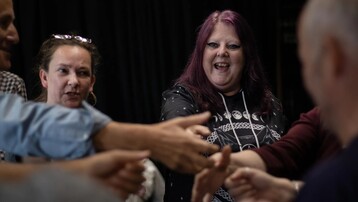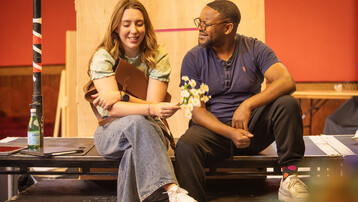News Story
We stopped in to ETO's lively rehearsal rooms to get a sneak peek at this season's productions and hear what directors and performers are thinking about as they bring The Snowmaiden and Blond Eckbert: Double Bill to life.

The Snowmaiden cast
Credit: Craig FullerThe Snowmaiden
Rimsky-Korsakov’s The Snowmaiden is a classic coming of age tale packed with colour and folk melodies. Olivia Fuchs (Director) says, "I think it was the piece he [Rimsky-Korsakov] was most proud of himself. He felt that he really found his voice in this. It’s hardly ever done, but it’s really great."

The Snowmaiden cast
Credit: Craig Fuller
Ed Danon (Mizgir)
Credit: Craig Fuller
Kitty Whately (Lel) and Phil Wilcox (Ensemble)
Credit: Craig Fuller
Katherine McIndoe (Kupava) and Kitty Whately (Lel)
Credit: Craig Fuller
Joseph Doody (Tsar Berendey) and Ffion Edwards (Snowmaiden)
Credit: Craig Fuller
Ed Hawkins (Grandfather Frost/Bermyata)
Credit: Craig FullerThe Snowmaiden features a large ensemble, who bring Rimsky-Korsakov's lively folk music to life throughout the opera. In conversation about creating these powerful musical moments, the cast describes...
Ed Danon (Mizgir): To hear a sound that big where you know that everything is coming from a human lung or a bow on a string… nothing between each performer and the audience and at a volume level that you’re only used to hearing at an amplified gig or something like that, that’s a really primal thing where the whole room is just vibrating with human-created sound.
Alexandra Meier (Tsar's Page): I find in those particular scenes there’s also a real communal aspect to it, because in a lot of those scenes there are many parts where the community gathers to all make music together, to all dance together, and it’s also a bonding experience for all of them [the characters].
Phoebe Smith (Ensemble): You can just feel in the rehearsal room that everyone is having so much fun in those big scenes. I’m sure it will be fun to see it as well.

Blond Eckbert: Double Bill
Judith Weir’s Blond Eckbert is a haunting tale of isolation and guilt, based on a supernatural short story by the Romantic author Ludwig Tieck. In ETO's double bill production, Blond Eckbert will be preceded by Do not take my story for a fairytale, a staging of song cycles and cantatas exploring love, isolation and the terrible wonder of the natural world.
These two halves of ETO's Blond Eckbert: Double Bill are connected through exploration of the Romantic imagination. Robin Norton-Hale (Director) believes this connects to our experience in the modern day saying, "What the Romantics were trying to do feels very contemporary, very individualistic. What is my place in the world? How do I look inwards to discover, you know, that’s a kind of thought that we do a lot of."

William Morgan (Walther, Hugo, Old Woman), Alex Otterburn (Eckbert) and Monica Nicolaides (Assistant and Movement Director)
Credit: Craig Fuller
Abigail Kelly (Soprano) and Amy J Payne (Mezzo)
Credit: Craig Fuller
Matthew McKinney (Tenor)
Credit: Craig Fuller
James Longford (Répétiteur) and Aoife Miskelly (Bird)
Credit: Craig Fuller
Amy J Payne (Mezzo)
Credit: Craig Fuller
Monica Nicolaides (Assistant and Movement Director) and Robin Norton-Hale (Director)
Credit: Craig FullerDo not take my story for a fairytale features music from the same period that Ludwig Tieck’s story, Der Blonde Eckbert, was written. Each piece will be staged, with performers moving around a set and even interacting with instrumentalists...
Robin Norton-Hale (Director): The music is exquisite… For the orchestration, we’ve got 14 players in the first half and 10 in the second, so it’s quite small. It means everyone is a soloist, all the singers and the players. Each line is doing it’s own unique thing, so it’s quite a different sound and quite delicate in a way.
Amy J Payne (Mezzo): Some of the musicians memorise their parts as well. They’re interacting with the performers.
Robin Norton-Hale: They’ll be in costume and the idea is they’re kind of part of the natural world.


